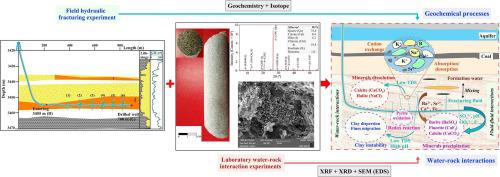Journal of Hydrology ( IF 5.9 ) Pub Date : 2022-08-06 , DOI: 10.1016/j.jhydrol.2022.128292 Xiaodong He , Peiyue Li , Jing Ning , Song He , Ningning Yang

|
The application of hydraulic fracturing has transformed tight sandstone gas into a very important global unconventional resource. The accurate description of geochemical processes during hydraulic fracturing can provide essential information for improving tight gas production. In this study, field fracturing and laboratory water-rock interaction experiments were designed and performed in conjunction with geochemistry, isotope, XRF, XRD and SEM techniques to reveal the prevalent geochemical processes. Sixty-five flowback fluid samples were collected from a hydraulic fracturing well and a tight sandstone sample was drilled from gas reservoir to perform water-rock interaction experiments. The results indicate that hydraulic fracturing flowback fluid is a complex mixture, with high TDS values (0.93–33.04 g/L) and heavy isotopes (e.g., mean δ18O of −5.35‰, mean 87Sr/86Sr of 0.714651). Geochemistry and isotope data reveal that the mixing process between fracturing fluid and formation water exerts an important influence on the flowback fluid chemistry, while water-rock and fluid-fluid interactions are also variably important during the hydraulic fracturing process. Pyrite oxidation process is confirmed during hydraulic fracturing in the tight sandstone reservoir, while the addition of gel breaker makes the process prominent. Due to high clay mineral contents (24%), ion exchange and adsorption/desorption are critical factors affecting the stability of the clay minerals during the entire fracturing and flowback processes. Approximately, 20%-43% of the strontium was removed from the solution by ion exchange between the 8 and 44 h intervals of the flowback process. The fractures derived from fracturing connect different types of high salinity formation water, leading to potential mineral precipitation (e.g., barite and calcite). The analysis of formation water needs to be taken into consideration during hydraulic fracturing operations.
中文翻译:

现场和实验室实验揭示了致密砂岩储层水力压裂过程中的地球化学过程
水力压裂技术的应用使致密砂岩气成为非常重要的全球非常规资源。准确描述水力压裂过程中的地球化学过程可为提高致密气产量提供重要信息。在这项研究中,结合地球化学、同位素、XRF、XRD 和 SEM 技术,设计并进行了现场压裂和实验室水-岩相互作用实验,以揭示普遍的地球化学过程。从一口水力压裂井中采集了 65 个返排液样品,并从气藏中钻取了一个致密砂岩样品,以进行水-岩相互作用实验。结果表明,水力压裂返排液是一种复杂的混合物,具有高 TDS 值(0.93-33.04 g/L)和重同位素(例如,平均 δ-5.35‰的18 O,平均87 Sr/ 86Sr 为 0.714651)。地球化学和同位素数据表明,压裂液与地层水的混合过程对返排液化学有重要影响,而水-岩和液-液相互作用在水力压裂过程中也有不同程度的重要影响。致密砂岩储层水力压裂证实了黄铁矿氧化过程,而破胶剂的加入使该过程更加突出。由于粘土矿物含量高(24%),离子交换和吸附/解吸是影响整个压裂和返排过程中粘土矿物稳定性的关键因素。大约 20%-43% 的锶通过回流过程的 8 和 44 小时间隔之间的离子交换从溶液中去除。压裂产生的裂缝连接不同类型的高盐度地层水,导致潜在的矿物沉淀(如重晶石和方解石)。在水力压裂作业中需要考虑地层水的分析。











































 京公网安备 11010802027423号
京公网安备 11010802027423号